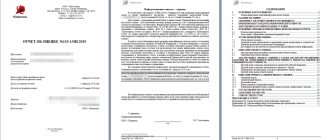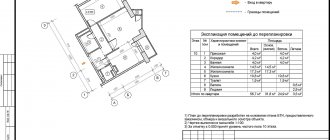Cadastral value is the equivalent of the market value of a property, obtained through an assessment taking into account its intended purpose and location.
Required for calculating land tax and setting prices for various real estate transactions.
Information about the cadastral value of each property is entered into the State Real Estate Cadastre.
The cadastral value can be determined by mass valuation or by calculating the individual value of an individual object.
The assessment is carried out by independent experts by decision of local authorities, who are required to select an appraiser and sign an agreement with him.
Description of the state procedure
A cadastral valuation is a list of technical and administrative actions to establish the cadastral value of objects on a specific date.
It is carried out using special techniques, taking into account information about transactions on the market, the level of rent, and the profitability of plots.
The appraiser studies and forecasts rent generation depending on the location and quality of the land . When calculating, it is necessary to take into account the improvements made, the level of transport and social infrastructure, and amenities.
The expert has the right to use information from various cadastres, housing and construction standards: coefficients developed by the BTI, authorities, land and architectural committees.
The cadastral value of land plots is determined depending on the territorial location, area, category and permitted use of the site.
Within the city limits, this is the simultaneous determination of the cost of objects en masse, which consists of :
- collecting information;
- dividing the city into zones;
- calculation of the cost of assessment;
- price zoning of the city;
- recording the assessment results.
The result is the establishment of the cost of a plot according to the assessment zone or the size of a typical plot, similar to the price of similar plots on the real estate market.
Officially establishing the cost and recording it in the Register allows you to solve several problems at the same time :
- The state is creating a unified system of taxation of land holdings of the state and private individuals, which allows optimizing the system of calculation and accounting of taxes, filling the budget and forecasting future volumes of tax revenues.
- Regional authorities have the opportunity to rationally use and manage plots of land, distribute real estate, and issue construction permits.
- Individual property owners have the opportunity to count on fair tax assessments, conduct real estate transactions, and make investments.
The cadastral value usually tends to the market level ; when it is carried out, almost all factors that are important in market valuation are taken into account, but it cannot exceed the market value.
Compliance with formal requirements is good, but not enough
Reviewing this dispute by way of supervision, the Presidium of the Supreme Arbitration Court in Resolution No. 13839/13 made two important conclusions.
The first conclusion is about the circle of persons recognized as subjects of legal relations in establishing the cadastral value of a land plot, the owner of which is a private person.
The second conclusion is about the need for the court to analyze the commission’s decision for the validity and reliability of the established market value.
As for the circle of interested parties, the senior arbitrators not only agreed with the conclusions of the FAS VSO that the local government body on whose territory the property is located has the right to independently challenge the decisions of the commissions, but also additionally indicated which other entities may enter into disputes regarding cadastral value size:
- tenants of the land plot. However, the arbitrators have previously recognized the fact that the tenant of a land plot has the right to challenge the cadastral value if the fee for its use is calculated taking into account its cadastral value (resolutions of the Federal Antimonopoly Service of the Eastern Military District dated 06.19.2014 No. A82-9984/2013, FAS North Kazakhstan region dated October 25 .2013 No. A53-23332/2012);
- legal holders who own land plots under the right of permanent (perpetual) use or lifelong inheritable possession;
- persons who, although they do not have formal rights to a land plot, own real estate located on it.
At the same time, the Presidium of the Supreme Arbitration Court emphasized: the court can independently determine other persons whose rights and legitimate interests may be affected when considering applications to challenge the decisions of the commission.
Regarding the circumstances that the court must establish when considering such disputes, the senior arbitrators noted that the court's verification of compliance only with formal requirements (powers of the commission, composition of documents, procedure for making a decision) without analysis and assessment of legal arguments regarding the actual market value of the property does not allow ensuring reliability of data, economic feasibility of taxation and balance of interests.
In short, as part of the judicial process, the arbitrators must not only check the fulfillment of all procedural requirements of the current legislation in relation to the commission’s decision, but also give a comprehensive answer about the reliability of the market value of the land. The commission itself is not vested with the authority to verify its accuracy; it only has the right to equalize the cadastral value and the market value, subject to two conditions:
- the applicant submitted a complete package of documents;
- the market value differs from the cadastral value by more than 30% (clause 20 of the Procedure [8]).
Taking into account the position of the Presidium of the Supreme Arbitration Court, in order to assess the reliability of the market value established by an independent appraiser, the courts will obviously be required to order a forensic examination of the appraiser's report to verify its compliance with the requirements of the Law on Valuation Activities (see, for example, Resolution of the Federal Antimonopoly Service dated 15.07 .2014 No. Ф09-3996/14).
Normative base
The conditions and regulations for conducting a cadastral valuation are regulated by the provisions of the Land Code of the Russian Federation and the following federal laws :
- “On state cadastral valuation” dated 07/03/2016 N 237-FZ
- “On cadastral activities” dated July 24, 2007 N 221-FZ
- “On state registration of real estate” dated July 13, 2015 N 218-FZ
- “On valuation activities in the Russian Federation” dated July 29, 1998 N 135-FZ
When assessing, you must rely on the following orders of the Ministry of Economic Development of the Russian Federation :
- Order of the Ministry of Economic Development of the Russian Federation dated 02/15/2007 N 39 (as amended on 01/11/2011) “On approval of the Methodological Guidelines for the State Cadastral Valuation of Land in Settlements”
- Order of the Ministry of Economic Development of the Russian Federation dated August 12, 2006 N 222 (as amended on November 17, 2011) “On approval of the Guidelines for determining the cadastral value of newly formed land plots and existing land plots in cases of changing the category of land, the type of permitted use or clarifying the area of the land plot”
- Order of the Ministry of Economic Development of Russia dated 06/07/2016 N 358 (as amended on 05/12/2017) “On approval of methodological instructions on state cadastral valuation”
- Order of the Ministry of Economic Development of Russia dated December 8, 2015 N 921 (as amended on November 23, 2016) “On approval of the form and composition of land survey plan information, requirements for its preparation”
- Order of the Ministry of Economic Development of the Russian Federation dated September 20, 2010 N 445 “On approval of the Guidelines for the state cadastral valuation of agricultural land”
Decrees of the Government of the Russian Federation applied during the assessment:
- Decree of the Government of the Russian Federation dated 04/08/2000 N 316 (as amended on 06/30/2010) “On approval of the Rules for conducting state cadastral valuation of land”
- Decree of the Government of the Russian Federation of August 25, 1999 N 945 “On the state cadastral valuation of land”
It is necessary to adhere to the legally approved Federal assessment standards :
- “General concepts of assessment, approaches and requirements for assessment (FSO N 1)”
- “Purpose of valuation and types of value (FSO N 2)”
- “Requirements for an assessment report (FSO N 3)”
- “Determination of cadastral value (FSO N 4)”
If the established cadastral value is not satisfactory...
The direct participants in the process of determining the cadastral value of a land plot are:
- customer of the work to determine the cadastral value. By virtue of Art. 24.12 of the Law on Valuation Activities, it is the executive body of state power of a constituent entity of the Russian Federation;
- territorial department of Rosreestr [5], which forms a list of real estate objects subject to state cadastral valuation, and also creates and coordinates the work of a special commission (Articles 24.13, 24.18 of the Law on Valuation Activities);
- the performer of the work is an independent appraiser involved in carrying out appraisal work in accordance with Federal Law No. 44-FZ [6];
- expert - SRO of appraisers, a member of which is the performer of appraisal work (Article 24.16 of the Law on Appraisal Activities);
- owner of the land.
The customer initiates the state cadastral valuation of real estate in the manner prescribed by the provisions of Art. 24.12 – 24.14 of the Law on Valuation Activities and other regulations.
The owner of the site, if he agrees with the results of this assessment, uses them in his activities (including the calculation of tax payments) or challenges them. In the latter case, if the owner believes that the cadastral value of the land plot is too high, he has the right to change it (of course, downward). How? To do this, he needs to enter into an agreement with independent appraisers and carry out an individual assessment of the land plot. In this case, the appraiser’s report, as required by law, must be supported by a positive expert opinion from the SRO, of which the appraiser is a member (Article 24.18 of the Law on Valuation Activities).
Essential point:
new edition of Art. 24.18 of the Law on Valuation Activities now contains a clause that pre-trial appeal of cadastral valuation results in a special commission is not mandatory only for individuals. Let us recall that the provisions of Art. 24.11 – 24.21 of the Law on Valuation Activities were rewritten by the legislator [7]. The amendments came into force on the date of official publication of Federal Law No. 225-FZ of July 21, 2014 (07/22/2014), with the exception of provisions for which a different period is provided. Previously, the results of cadastral valuation of real estate (including land plots) could be challenged in a special commission or arbitration court (Article 24.19 as amended).
Thus, from Art. 24.18 of the Law on Valuation Activities it follows that for legal entities - owners of land plots, the process of challenging the cadastral value consists of two stages: the first is challenging in the commission, the second is appealing the decision made by the commission in court.
Dates
The assessment results are entered into the unified State Register after their approval by the local administration.
The results are posted on the Rosreestr website and in print.
They are valid for at least 5 years until the subsequent cadastral valuation, which is carried out once every 3 years, but at least once every 5 years .
During this period, the size of the cadastral value remains unchanged.
Before the end of the 5-year period, the price can only be changed if necessary :
- change the area or boundaries of the site;
- change the type of destination;
- transfer to another category;
- correct any errors found in the documentation used during the assessment.
During this period, the value of the property on the market may also change due to changes in market conditions, which leads to a decrease in the cadastral value.
In addition, the objective characteristics of the site may change as a result of natural factors, for example, floods, earthquakes, landslides, and road construction.
The cadastral value can be changed at the request of the owner by contacting the local office of Rosreestr or in court.
The new value is considered to come into force from the moment the information is entered into the State Property Committee and the Unified State Register of Rights to Real Estate.
Stakeholders: who are they?
The grounds for appealing the assessment results to the commission are the circumstances named in paragraph. 12 – 14 tbsp. 24.18 of the Law on Valuation Activities:
- unreliability
of information about the property used in determining its cadastral value; - establishing
in relation to a real estate object its
market value
on the date as of which its cadastral value was established.
At the first stage of challenging the cadastral value, the interested parties are the owners of land plots: legal entities or public authorities (or local governments). This follows from paragraph. 10 tbsp. 24.18 of the named article.
Paragraphs 15 and 16 of this article clarify in which cases complaints can be filed: in cases where the results of determining the cadastral value affect the rights and obligations of legal entities
.
The commission has the right to make two types of decisions: either to satisfy the applicant’s requirements (for example, to equalize the cadastral and market value of the property), or to reject the application of the interested party.
The commission's decisions can be challenged in court (second stage).
Note that the provisions of Ch. III.1 of the Law on Valuation Activities in the previous edition did not determine who and on what grounds could challenge the decisions of the commission in court.
The new edition fills this gap in the legislation, but only partially. Yes, para. 38 Art. 24.18 of the Law on Valuation Activities now establishes that the results of cadastral valuation can be challenged by legal entities
in the event that the results of determining the cadastral value
affect the rights and obligations of these persons, as well as government authorities
in relation to a property
located in state or municipal ownership, in court
on the grounds mentioned above,
only if the commission rejects the application
for revision of the cadastral value filed on the appropriate grounds, or in case the commission violates the deadlines for considering such an application.
Thus, by virtue of the direct indication of the law, persons interested in challenging the cadastral value are legal entities whose interests affect
cadastral valuation results.
Note that interest
in this case is the key point.
Meanwhile, based on the wording of the mentioned paragraph, it is impossible to make an unambiguous conclusion whether the executive body (for example, the city administration) has the right to independently
appeal the commission’s decision (in particular, a positive decision to recognize the cadastral value as equal to the market value) taken in relation to a land plot owned by a private person.
However, the legal position of the Presidium of the Supreme Arbitration Court, set out in Resolution No. 13839/13, leaves no doubt on this score. We emphasize that the conclusions of the senior arbitrators were made in relation to the provisions of Chapter. III.1 of the Law on Valuation Activities as amended (in particular, Article 24.19). But despite the efforts of the legislator to specify the legal norms, they are also relevant for the new edition of the said chapter.
How is it carried out?
The procedure begins after the decision to conduct the assessment is made.
Carried out in several stages:
- A list of objects requiring cadastral valuation is being compiled.
- An independent appraiser is selected and a contract is concluded.
- A cadastral valuation is being carried out.
- A report is drawn up, a draft of which must first be submitted for review.
- The report is being reviewed.
- The results of the work of the appraisers are approved.
- The results are entered into the Unified Real Estate Register.
This procedure is preceded by a preparatory stage , during which:
- Information is collected about the climatic, environmental and hydrographic features of the zone.
- Zones are established according to the general plan if urban objects are assessed.
- Plots are classified according to land users and ownership.
- Classification is made according to functional purpose, urban planning value, type of use (residential, public-business or industrial zones).
- Current use is assessed and the direction of assessment zones is predicted.
- Typical areas and assessment zones are established based on market data.
How often should cadastral valuation be carried out?
According to Art. 24.12 of the Law on Valuation Activities, valuations will now be carried out no more often
than once within three years (in federal cities no more than once within two years) and
at least
once within five years from the date as of which the state cadastral valuation was carried out. The assessment is carried out by decision of the authorities.
The previous wording of the norm - at least once every five years
– practically did not limit the frequency of assessment.
In addition, the new wording of Art. 24.12 defines a list of mandatory information that must be reflected in the decision of the authority to conduct an assessment. These include the year the assessment work began, the types of real estate for which the assessment is being carried out, as well as the categories of land plots, if the type of real estate is land plots.
The previous edition of the article did not provide such a list.
Methodology
For cadastral valuation of land plots, experts use a variety of techniques that are based on three main approaches to valuation: cost-based, comparative and profitable.
Cost-effective approach
It is used when evaluating unique properties that cannot be compared with other real estate due to the lack of such, or this land plot is not in consumer demand.
The cost of the site is determined.
Construction specifics, wear and tear, and the price of the site for the most effective method of use are taken into account.
Comparative
It consists of assessing standard objects that have many analogues for comparison; a lot of information is available about the market value of such objects.
Despite its simplicity and high correctness, this approach takes into account only the current state of the market; this state changes over time.
Methods are based on this approach:
- Sales comparisons to evaluate developed or undeveloped sites, taking into account sale prices and offers of similar sites.
- Allocations for the assessment of built-up areas, which combine the comparison method and elements of the cost approach. Information on prices for transactions with single similar objects and the possibility of the most effective use, taking into account the improvements made, are taken into account.
- Allocations for built-up areas. Information is collected on prices for single objects similar to this one, taking into account the share of the site in the market value of the single object and the possibility of effective use according to the improvements carried out.
- Intended use, to determine whether the site can be used to generate income.
- Capitalization of rent, considers the possibility of obtaining income from a developed or undeveloped plot, taking into account the capitalization rate and market value.
- The remainder is being considered for improvement by developing the site to generate income.
Profitable
Preferred when planning income from commercial operation , defined as expected income. The amount is determined based on a study of previously received income.
The basics of financial mathematics, capitalization and discounting are used:
- taking into account the risks of investing capital;
- with the ability to forecast cash flows;
- analyze information from a given market segment;
- anticipate possible changes in the value of an object under the influence of external factors.
This is the most reliable and information-rich method for business objects.
Procedure for appealing cadastral valuation results
New edition of Art. 24.18 of the Law on Valuation Activities now contains a clause stating that pre-trial appeal to the commission of the results of determining the cadastral value is not mandatory only for individuals.
On what date can the cadastral valuation results be challenged?
There is no clear answer to this law. Article 24.18 states the following: in case of challenging the results of determining the cadastral value, the market value of the property must be established on the date as of which its cadastral value was established
.
As you can see, this refers to the date of establishment
cadastral value.
And this is already the third date that is used by the legislator. Note that the previous edition (Article 24.19) contains almost identical wording. The only difference is that the new edition speaks of a date that has been set
, while previously it spoke
of a date that has been set
. Agree, the difference is small.
Meanwhile, the legislator, limiting himself to only a technical amendment, as before, does not directly state what is considered the date of establishment
cadastral value (as opposed to the two above-mentioned dates).
In the Explanations of the Department of Innovative Development and Corporate Governance of the Ministry of Economic Development of Russia on the issues of determining cadastral value dated December 15, 2011, department officials expressed an opinion on the feasibility
application of the market value determined in relation to the disputed land plots individually in the assessment report, as of the date as of which the cadastral value of such land plots was established.
Thus, taking into account together the provisions of the Law on Valuation Activities, by-laws regulating the procedure for conducting cadastral valuation [6], clarifications of the official body, and taking into account the need to ensure the correlation between the market and cadastral values of the object and the use of existing pricing factors when determining the market value at the same moment at which they were used by appraisers when determining the cadastral value, the date of establishing the cadastral value should be understood as the date of determining the cadastral value.
This is indirectly confirmed by the fact that from the point of view of the Russian language, the words “establish” and “define” are synonymous.
Features of land valuation for various purposes
The assessment of lands for different purposes is based on the comparative method, that is, on comparing information about the dynamics of price changes, any other information about the plots, using different methods.
Lands usually belong to urban or rural settlements, vegetable gardening, horticultural or dacha societies.
If an agricultural plot is located beyond the border of urban and rural settlements , then the income method is applied, that is, the level of capitalization of rental income is determined. Soil fertility, location, and technological properties are determined.
If the land belongs to other categories and is located outside rural and urban settlements , then a cost or income method is used:
- determination of capitalization of estimated rental income;
- accounting for the costs of growing, maintaining or preserving the value of the natural potential of these lands.
Requirements for State Budgetary Institution specialists carrying out cadastral valuation of real estate
GBU employees who determine the cadastral value must meet the following qualification requirements :
- have a higher education in one of the fields: management, economics, mathematics, computer science, geoscience, biology, architecture, technology, applied geology, geodesy, mining, oil and gas, business, agriculture, forestry and fisheries;
- be unconvicted citizens of the Russian Federation;
- have experience in the field of determining cadastral value (from 3 years) - for those who sign the cadastral value report.
Requirements for employees of the State Budgetary Institution for cadastral valuation are prescribed at the federal level in Law 237-FZ, as well as in Order of the Ministry of Economic Development dated July 12, 2017 No. 177.
Challenging
If you disagree with the cost of the assessment, the owner of the site has the right to challenge it.
To begin with, you can contact the State Register office at the location of the object with a corresponding application.
This organization has a commission to resolve disputes regarding the results of determining the cadastral value. A response may be received within 30 days.
The practice is that this commission rarely makes a decision in favor of the applicant, so you can immediately go to court .
If you receive a refusal to revise the value of the property, you should file a statement of claim with the court. The cadastre departments become defendants in the case.
The established cadastral value does not always express the standard average cost of land or apartment. Each case is individual and has its own characteristics.
The cadastral value usually takes into account everything that is outside the property : its size is influenced by the city, region, and infrastructure.
Approval of cadastral valuation results
After examining the report on determining the cadastral value of the self-regulatory organization of appraisers, the body that made the decision to conduct a state cadastral valuation must approve this report. Article 24.17 of the Law on Valuation Activities provides 20 working days for this. The previous version of this article – 10 working days. Approval of the results of the assessment is documented in a corresponding act.
This act comes into force after its official publication (!).
Accordingly, the date of approval
the results of determining the cadastral value is considered to be
the date of entry into force
of the act approving the results of determining the cadastral value and the corresponding norm of such an act.
This is another date that is included in the new edition of Chapter. III.1 of the Law on Valuation Activities. That is, two dates are now legally defined that are directly related to the cadastral value of real estate: the date of determination of the cadastral value
and
the date of approval of the cadastral valuation results
.
The first is determined - this is the date as of which the list of real estate for assessment was generated. The second directly depends on the date of official publication of the act approving the results of the state cadastral valuation. At the same time, Art. 24.18 (as amended), regulating the procedure for publishing this document, has become invalid. Now in the norms of Ch. III.1 of the Law on Valuation Activities contains instructions on the need for the official publication of the act (otherwise it will not come into force), but neither the timing nor the procedure for its publication are defined. Obviously, this point needs clarification, since the concept of “date of approval” is defined vaguely and ambiguously.








